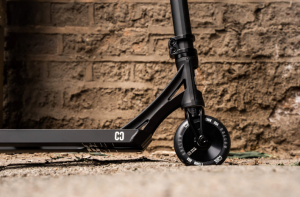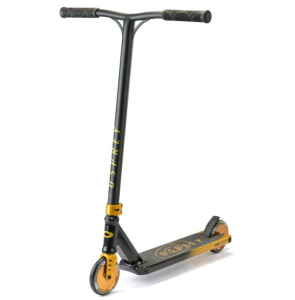
Design and Features
Key Components of a Stunt Scooter
The design of a stunt scooter is a culmination of several key components, each playing a critical role in its overall performance and durability. The deck is the heart of the scooter, providing the platform on which the rider stands. Modern decks are made of lightweight yet strong materials like aluminum, and their sizes vary to accommodate different riding styles and foot sizes.
Handlebars are another crucial element, directly impacting the scooter’s control and stability. They are usually made from steel or titanium for strength and are fixed in position, unlike those of foldable or adjustable scooters. The height and width of the bars vary, but they generally align with the rider’s height for optimal control.
Wheels are the point of contact with the ground and significantly affect the ride quality. Stunt scooter wheels are typically made of a hard urethane for durability and are smaller in diameter (usually around 100mm to 120mm) compared to traditional scooters. This smaller size allows for quicker acceleration and more responsive handling.
Other vital components include the fork, which holds the front wheel and connects to the bars, and the compression system, which keeps the scooter tight and rattle-free. The brake system, usually a flex fender, is simple yet effective, allowing riders to stop quickly without adding much weight to the scooter.
Materials and Durability
The materials used in stunt scooters are selected for their ability to withstand the high impacts and stresses of stunt riding. Durability is paramount, as the scooter must endure repeated jumps, tricks, and sometimes falls.
Aluminum is a popular choice for decks due to its combination of strength and lightness. Some high-end models use advanced alloys or even titanium for greater strength-to-weight ratios. The handlebars, often made of steel or titanium, offer the necessary robustness and resilience against bending or breaking.
In terms of wheels, polyurethane is the standard material, known for its hardness and ability to resist wear. The cores of the wheels are often made of aluminum or sometimes reinforced nylon for additional strength.
Bearings, usually rated with an ABEC (Annular Bearing Engineering Committee) score, determine the wheel’s smoothness and speed. Higher-rated bearings (like ABEC 9 or 11) offer smoother, faster rides but can be more expensive.
The longevity of a stunt scooter largely depends on the quality of these materials and the construction. While the initial cost of a high-quality stunt scooter may be higher, it often translates into better performance, safety, and a longer lifespan, making it a worthwhile investment for serious riders. The choice of materials also affects the scooter’s weight, which is a crucial factor for performing certain tricks. Lighter scooters are easier to lift and maneuver in the air, but they must also maintain the structural integrity to withstand the impacts of stunt riding.
Types of Stunt Scooters
Beginner Scooters
Beginner stunt scooters are designed for those just starting in the sport. Their primary focus is on stability and ease of use. These scooters often feature wider decks to provide a more stable platform for learners. The handlebars are typically aligned with the rider’s hip height to ensure comfortable control.
In terms of materials, beginner scooters use robust but more affordable materials like standard aluminum and steel. The wheels are usually made of polyurethane with a lower durometer, which offers more grip and a smoother ride, essential for new riders. These scooters also have simpler compression systems and standard bearings, balancing cost and performance.
Professional Scooters
Professional stunt scooters, on the other hand, are tailored for experienced riders and those participating in competitions. They emphasize high performance, agility, and durability. These scooters have narrower decks for more precise foot placement and tricks. The handlebars are often taller and made of higher-grade materials like reinforced steel or titanium.
The use of advanced materials like aircraft-grade aluminum or even carbon fiber is common in professional scooters. This not only reduces weight but also ensures the scooter can withstand the high impacts of advanced tricks. Wheels in professional scooters are typically harder with a higher durometer rating, allowing for faster speeds and better control. They also come with high-rated ABEC bearings for optimum speed and smoothness.
Below is a comparison table highlighting the key differences:
| Feature | Beginner Scooters | Professional Scooters |
|---|
| Deck Size | Wider for stability | Narrower for precision |
| Handlebar Height | Hip height for comfort | Taller for better control |
| Materials | Standard aluminum and steel | Advanced alloys, carbon fiber |
| Wheel Durability | Lower durometer for grip | Higher durometer for speed |
| Bearings | Standard ratings (e.g., ABEC 5) | Higher ratings (e.g., ABEC 9) |
| Compression System | Simpler systems | Advanced systems for stability |
| Price Range | More affordable | Higher due to advanced materials |
Both beginner and professional scooters have their specific design elements and material choices, each catering to the different needs and skill levels of riders. As one progresses in the sport, the transition from a beginner to a professional scooter allows for the development of more complex tricks and a better overall riding experience.

Stunt Scootering Techniques
Basic Tricks and Skills
Mastering basic tricks and skills is essential for any aspiring stunt scooter rider. The first and foremost skill to learn is the Bunny Hop. This fundamental trick involves jumping with the scooter, keeping both wheels off the ground simultaneously. It’s the cornerstone for many advanced tricks and helps in developing balance and control.
Another essential trick for beginners is the Manual, a move where the rider balances on the rear wheel while rolling. It demands good control and balance, teaching riders how to manage weight distribution on the scooter.
The Tailwhip is a popular basic trick where the scooter deck is spun 360 degrees around the handlebars while the rider is in the air. This trick lays the foundation for more complex aerial maneuvers.
A basic grind, where the rider slides the deck along a rail or edge, introduces beginners to park riding. It’s a skill that requires precision and timing, important for more advanced grinding tricks.
Advanced Stunts and Maneuvers
For experienced riders, advanced stunts and maneuvers offer a challenge and a way to showcase their skills. The Backflip and Frontflip are two of the most sought-after advanced tricks. These aerial maneuvers involve flipping backward or forward while in the air, requiring exceptional air control and confidence.
The Flair, a combination of a backflip and a 180-degree spin, is another high-level trick. It demands a perfect blend of rotational and flipping skills, often performed on quarter-pipes in skate parks.
360-degree spins and variations, such as 360 Tailwhip or 360 Barspin, are advanced maneuvers that involve spinning the scooter and possibly performing additional tricks mid-air. These tricks test a rider’s ability to combine different skills seamlessly.
For park riders, advanced grinding skills like the Feeble Grind or Smith Grind, where different parts of the scooter slide along a rail or edge, are crucial. These require not only balance and precision but also creativity in execution.
Advanced stunts often push the boundaries of what’s possible on a stunt scooter, reflecting the rider’s skill, experience, and style. They require not only physical ability but also mental preparation, as the risk of injury is higher compared to basic tricks. However, the thrill and satisfaction of mastering these advanced maneuvers are unmatched, making them a key goal for many passionate stunt scooter riders.

Safety and Equipment
Essential Safety Gear
Safety is paramount in stunt scootering, and wearing the right gear is crucial for minimizing the risk of injury. The most important piece of safety equipment is the helmet. A high-quality helmet that fits well can significantly reduce the risk of head injuries, which are among the most serious in extreme sports. Helmets designed for skateboarding or BMX are ideal, as they are built to withstand multiple impacts and cover more of the back of the head.
Wrist guards, knee pads, and elbow pads are also essential. These pieces of gear protect the joints and limbs during falls, which are common in stunt scootering. Wrist guards, in particular, can prevent wrist fractures and sprains – common injuries in this sport. Pads should have a snug fit and be sturdy enough to absorb impacts.
Another important piece of safety gear is ankle supports. Ankle injuries are frequent in stunt scootering due to the high-impact nature of the tricks. Proper ankle supports can provide stability and reduce the risk of sprains.
Best Practices for Safe Scootering
Apart from wearing protective gear, following best practices for safe scootering is vital for reducing injury risks. Riders should always inspect their scooter before riding, checking for loose bolts, worn-out parts, and ensuring that all components are in good working condition. A well-maintained scooter is less likely to malfunction and cause accidents.
Learning to fall correctly is an essential skill in stunt scootering. Practicing how to roll out of a fall or slide can minimize injury during a crash. Beginners should start learning tricks in a controlled environment, such as a skate park with proper ramps and foam pits, under the guidance of experienced riders or coaches.
Understanding one’s limits is also key. Riders should progressively build their skills and not attempt advanced tricks without mastering the basics. Pushing beyond one’s skill level increases the risk of serious injury.
Community awareness and respect for other riders are crucial, especially in skate parks. Taking turns, being aware of others’ movements, and maintaining a safe distance help prevent collisions and accidents.
What distinguishes a stunt scooter from a regular scooter?
A stunt scooter features a reinforced structure, fixed handlebars, and smaller, harder wheels, making it ideal for tricks and high-impact riding, unlike regular scooters.
Are stunt scooters suitable for beginners?
Yes, there are beginner stunt scooters with wider decks and stable designs, perfect for those new to the sport and learning basic tricks.
How do professional stunt scooters differ from beginner models?
Professional scooters are lighter, with narrower decks and higher-grade materials like carbon fiber, designed for advanced tricks and higher performance.
What are some advanced tricks in stunt scootering?
Advanced tricks include Backflips, Frontflips, 360-degree spins, and complex grinds like the Feeble Grind, requiring high skill and control.



